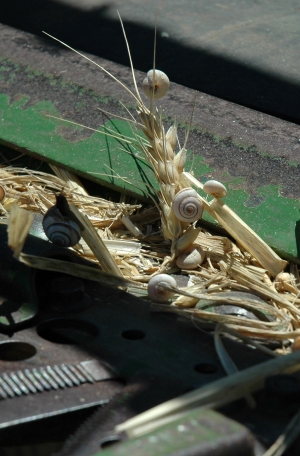Snail control improves harvest efficiency and quality
Snail control improves harvest efficiency and quality
Date: 06 Oct 2020

Snail awareness and control will help growers protect the value of their grain and avoid costly delays from clogged headers at harvest time.
Entomologist Kym Perry, from the South Australian Department of Primary Industries and Regions’ research division, the South Australian Research and Development Institute (SARDI), says understanding snail behaviour can help minimise their impact at harvest.
“In spring, snails climb plants to avoid heat from the soil,” says Dr Perry, whose research is through Grains Research and Development Corporation (GRDC) investment.
“As temperatures rise, they increasingly shelter in crop canopies, sometimes between grains in the seed head, and become very difficult to dislodge.”
While recognising that snail dynamics and harvest operations are different on every farm, harvesting high-value crops or infested crops early is one strategy to help growers manage snail contamination.
“Plants are more resilient at early maturity and snails will be easier to dislodge before temperatures peak,” Dr Perry says.
Monitoring snail movement can also assist with timing harvest operations to keep snails out of the header.
“Recent camera studies showed that snails frequently move up and down plant canopies during spring, presumably collecting food and moisture reserves and seeking aestivation sites in preparation for summer,” Dr Perry says.
“Much of this spring movement occurs during the night and early morning, or in response to light moisture events, particularly earlier in spring.
“During the heat of the day, and later in spring, we find they are more likely to settle in the crop canopy.
“Monitoring snail movements can help growers decide the best times of the day to harvest snail-infested areas, taking into account the need to meet grain moisture content specifications.”
Dr Perry says establishing where snails are concentrated on their property allows growers to manage areas with a high snail contamination risk.
“Farmers often know the problem areas on their farm, but snail densities vary across seasons,” he says.
“Monitoring live snail densities three to four weeks before harvest is recommended to allow time to plan the harvest accordingly.”
Monitoring for live snails is best done with a 30 x 30 centimetre square sampling frame. Move in a straight line from the edge of the paddock to the centre, placing the frame down at 10 metre intervals and counting the snails within it.
High snail numbers can cause problems with the smooth running of headers.
Along with clogging sieves, the combination of snail guts and dust can stick to the inside of machinery and set hard.
Stripper fronts have been found to reduce snail contamination in cereal grain by up to 50 per cent compared to a standard open front. Alternatively, raising the cutting height can reduce snail intake but results in more standing stubble that may need to be managed afterwards.
Grain in heavily infested areas can be harvested and stored separately from the main bulk, then cleaned with snail crushing rollers.
“Snail crusher rollers are an important tool for cleaning snails out of harvested grain but are most effective if snail numbers in the sample have already been minimised through good in-paddock management,” Dr Perry says.
“Grain cleaning is the last resort.”
Dr Perry reminds growers that harvest remains the worst time to manage a snail problem.
“Snail control must be a year-round program starting with rolling, cabling or even grazing stubble during the hottest part of summer to dislodge and kill sheltering snails, ensuring careful management of fire risk,” he says.
“Killing summer weeds will also deny snails shelter and food.
“This should be followed by a baiting program focused in early autumn, continuing as necessary until mid-winter, to kill active snails before they can breed and infest the next season’s crop.”
More information on snail management ahead of harvest can be found in the a GRDC Paddock Practices article.
Contact details
For interviews
PIRSA Media
pirsa.media@sa.gov.au
Contact
GRDC Adelaide office Communications Manager – South
(08) 8198 8400
media@grdc.com.au
